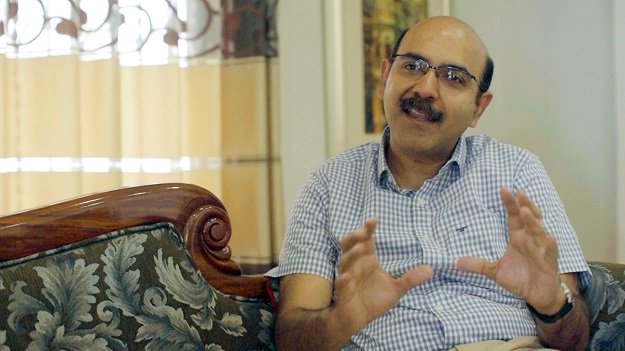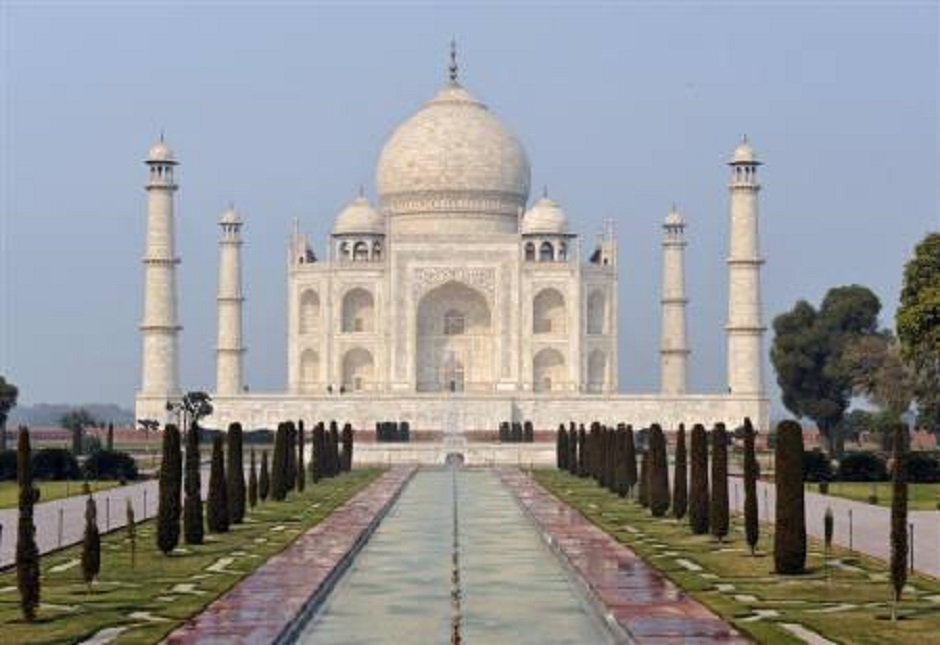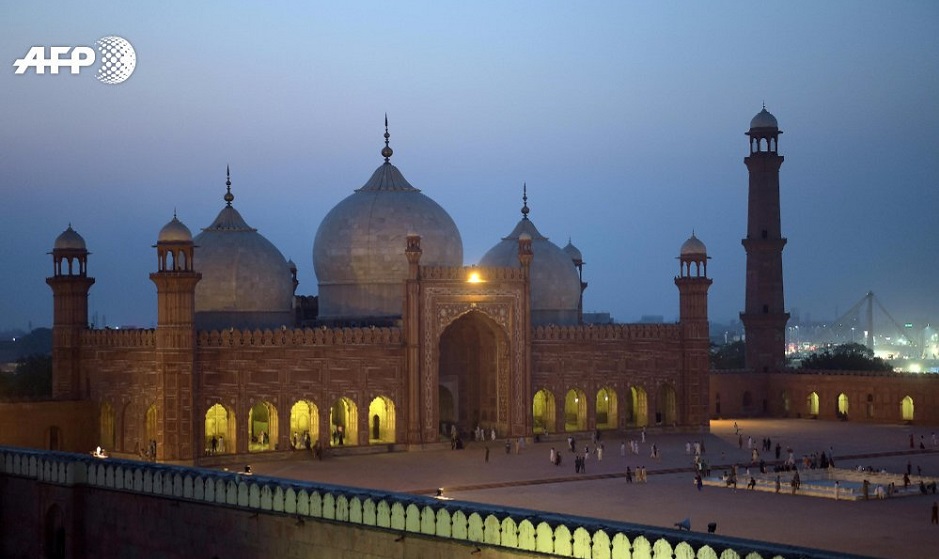
 Taj Mahal is an ivory-white marble mausoleum in the Indian city of Agra which was commissioned in 1632 by the Mughal emperor, Shah Jaha. PHOTO: REUTERS
Taj Mahal is an ivory-white marble mausoleum in the Indian city of Agra which was commissioned in 1632 by the Mughal emperor, Shah Jaha. PHOTO: REUTERS Badshahi Mosque in Lahore was commissioned by Mughal Emperor Aurangzeb in 1671. PHOTO: AFP
Badshahi Mosque in Lahore was commissioned by Mughal Emperor Aurangzeb in 1671. PHOTO: AFPConversely, when most people think of their forebears and namesakes, the Mongols, they think of a violent and barbaric horde that left nothing but destruction in its wake. That razed the Great Library of Baghdad and up until the 20th century, was the worst scourge the world had ever seen.
In the popular imagination, the two civilisations seem almost poles apart. But at least one history scholar believes that it was, in fact, the Mongols who inspired the model of religious and ethnic tolerance that the Mughals adopted and promoted. The Express Tribune met up with Professor Azfar Moin – who specialises in the history of Islam in South Asia and the Mughal Empire, and teaches history and religious studies at the University of Texas at Austin – and spoke to him in depth about the Mughal imperial policy of Sulh-e-Kul and the debates surrounding its origin.

ET: So what exactly is Sulh-e-Kul? What does it mean and what exactly inspired the Mughals to enact it in their realm?
AM: The conventional view of explaining the Mughal imperial policy called Sulh-e-Kul – which in very simple words meant exactly what it says which is ‘peace with all religions’; it is also translated as universal peace or total peace, and one historian has even argued that we should call it universal civility – is that it was an ethic to inculcate religious diversity and tolerate religious difference. It was the Mughal dynasty’s way of managing religious and cultural diversity within their empire.
There have been various arguments about what inspired the Mughals. A common belief is that it was the Chishti Sufis, who were open-minded and accommodating of various religions within India, inspired this Mughal attitude.
Scholars have also argued that the ideal came from Persian wisdom literature; ‘The Mirror of Princes’ or advice literature on how to rule as just kings. Still, others have argued that you can find such an attitude towards religion in Sufi metaphysics such as the ideas of Ibn al-‘Arabi.
While all of these cultural traditions may have played a role, I offer a new argument, which I recently presented at the Radhakrishnan Memorial lectures at Oxford, that the model that the Mughals followed came from an earlier empire not in India but rather in Iran and Central Asia. It was the empire of the Mongols.
Normally we conceive of the Mongols as extremely violent and a destructive force especially for the Islamic lands of Iran and Central Asia but the fact is that the non-Muslim Mongols had implemented a religious policy under which all religions under their empire were treated equally.
The Mongols had ruled over a religiously diverse population. They had Buddhists among their subjects, they had Sunnis and Shias under their rule, and they patronized various forms of Christianity. They had a very simple principle, which was that as long as various religious communities in their dominion prayed for the empire, they could practice their religions with few restrictions. By contrast, the religious policy of Christian and Muslim kingdoms of the era was quite intolerant.
I think that the Mughal policy was in many ways a revival of these earlier Mongol practices which were preserved in imperial chronicles since the early Ilkhanates and were the part of the Timurid legacy that the Mughals brought with them to India. It’s a source of history that we normally don’t think about when we imagine the Mughals in India that they may have actually been inspired by Mongol legacy outside of India.
ET: Would it be correct to assume that this policy of Sulh-e-Kul was successful? What does the scholarship say on that?
AM: To put it simply, there are two positions. One is that the policy didn’t go anywhere. This is the older conventional view that Sulh-e-Kul, which we first hear about the late 16th century, is abandoned after Jehangir’s reign.
However, new scholarship published in the last five to ten years has given us a new perspective. In this view, even though the official record might have become quiet on Sulh-e-Kul, the expression continues to be mentioned at the sub-imperial level.
What seems to have occurred is that the official policy spreads down and across the imperial bureaucracy and becomes part of a widespread ethic. People who are part of the Mughal service gentry imbibe this ethic; that when you join Mughal service, you must learn to accommodate religious difference and to keep religion out of public discourse. If, as a Mughal functionary, you think you are going to say or do something that could cause offence it is better not to say or do it publically. Or if you see or hear something that you think is controversial, you try to ignore it.
The new scholarly perspective helps us understand how the Mughal empire was successful in creating a new imperial culture, which survives even after the empire breaks down after the early 18th century. For example, the last time we hear the expression Sulh-e-Kul is when [Altaf Hussain] Hali writes the biography of Ghalib. When he describes the great poet’s religious attitude, he says that it was Sulh-e-Kul. So, if we can imagine Ghalib as the last Mughal gentleman, then we can see that even in the middle of the nineteenth century when the British ruled Delhi, this Mughal imperial ethic was still active.
ET: What about pushback? Did the Mughal policy of Sulh-e-Kul encounter any resistance from the orthodoxies in various religions within their realm?
AM: Obviously, there was resistance. Sulh-e-Kul was not just simply a form of advice. The Mughals made it the law of the land that had the force of the state behind it. They forbade violence and disputes based on religious differences.
The reaction, especially from various orthodox Muslim circles, was strong. There were people who wanted their religion or sect to be imposed and not be treated as equal to other traditions.
I think the opposition’s reaction was summed up best by the Jesuit missionary, Father Monserrate, who was invited to the Mughal court. At first, the Jesuits were very excited because they could go and openly spread Christianity, which would not have been possible in any other part of the Muslim world. But then they realised that the Mughal policy was that they would never allow one religion to be made supreme over all the others. What Monserrate said is very revealing; that Akbar “cared little that, in allowing everyone to follow his own religion, he was, in reality, violating all religions.”
ET: You mention Akbar. When most people think of Akbar, they usually think of Din-e-Ilahi. Was it, as most of us have been taught, a new religion or was it an extension of or simply another name for Sulh-e-Kul?
AM: Lots of ink has been spilt on Akbar’s controversial religious policies, specifically the idea that he tried to create a new religion called Deen-e-Ilahi or divine religion. The interesting thing is that the official imperial sources of the Mughal Empire do not mention anything like Deen-e-Ilahi.
The term comes to us from critiques of Akbar. It is Akbar’s critics who accuse him of creating a new religion. The official sources do not mention anything like Deen-e-Ilahi or Tauheed-e-Ilahi or all these names that are used to describe Akbar’s alleged religion. The official imperial sources consistently mention one thing, which is the policy of peace with all religions, or Sulh-e-Kul.
Now the irony is that modern scholarship has taken the critique of Akbar seriously and focused on understanding the so-called Deen-e-Ilahi, what it was and where it came from, while the official imperial policy of peace with all religions is something that has remained relatively less well studied.
ET: Is this one example of the pushback we just talked about?
AM: Yes, precisely. To put it somewhat simply, those who did not like this policy accused the Mughals of trying to create a new religion.
ET: All this talk of Sulh-e-Kul, peace with all religions, makes one imagine a sort of golden age of tolerance in South Asia, especially in light of these waves of extremism, sectarianism and intolerance across not just religious, but ethnic and linguistic lines in both Pakistan and India. Where did it all go so wrong for South Asia?
AM: You could explain this as an outcome of the rise and fall of empires. Over time, as the Mughal Empire had spread across South Asia, it created this ethic because it wanted people to get along within its dominions. Even after this empire ran its natural course and became fragmented, the ethic lived on in the various regional states that developed after the Mughal empire – in Bengal, in Punjab, in Awadh and so on.
But then a new empire, the British Empire, came to power and with it, the old imperial ethic came to an end. We talked about Ghalib as an example, who straddled both worlds. The older ethic came to an end because that way of life and that way of learning about how to live in a religiously diverse was gradually abandoned under the British. For example, much of the Mughal imperial ethic was taught in Persian. When the British stopped using Persian in the 1830s, how was one going to learn about this ethic?
In the 19th century, we see Persian replaced by vernacular languages such as Hindi and Urdu. This meant the rise of new linguistic identities, which then became tied to new religious identities. For instance, the same spoken language, which used to be called Hindustani, when it began to be written in the Devanagari script became Hindi and when it began to be written in the Perso-Arabic script it became known as Urdu. Eventually, these languages became strongly identified with distinct religious identities. This is the historical moment we are living in.
ET: So, are there any lessons leaders and governments in Pakistan, India and the rest of South Asia can learn from the Mughals and Sulh-e-Kul?
AM: I think it’s always good to reflect upon a time in history that was very different from our own experience because it helps us understand that things have not always been the way they are. For some of us at least, it can provide hope that there might be a better future in store.
Watch the video interview here:










































COMMENTS (1)
Comments are moderated and generally will be posted if they are on-topic and not abusive.
For more information, please see our Comments FAQ